Evaluating HRM Strategy, External Factors and HR Role at Tesco Plc
VerifiedAdded on 2023/06/14
|12
|3831
|353
Report
AI Summary
This report provides a comprehensive analysis of Human Resource Management (HRM) within Tesco Plc, a British international grocery and merchandise retailer. It begins with a SWOT analysis to evaluate Tesco's internal strengths and weaknesses, as well as external opportunities and threats. The report then utilizes Porter's generic strategies model to assess Tesco's competitive approach, recommending a cost leadership strategy. Furthermore, it examines external factors influencing Tesco's employment policies and practices using a PESTLE analysis, highlighting political, economic, social, technological, legal, and environmental considerations. Finally, the report evaluates HR's role within Tesco, referencing Ulrich's (1988) vision for the HR function, and emphasizing the importance of fair employment policies for multinational companies like Tesco.
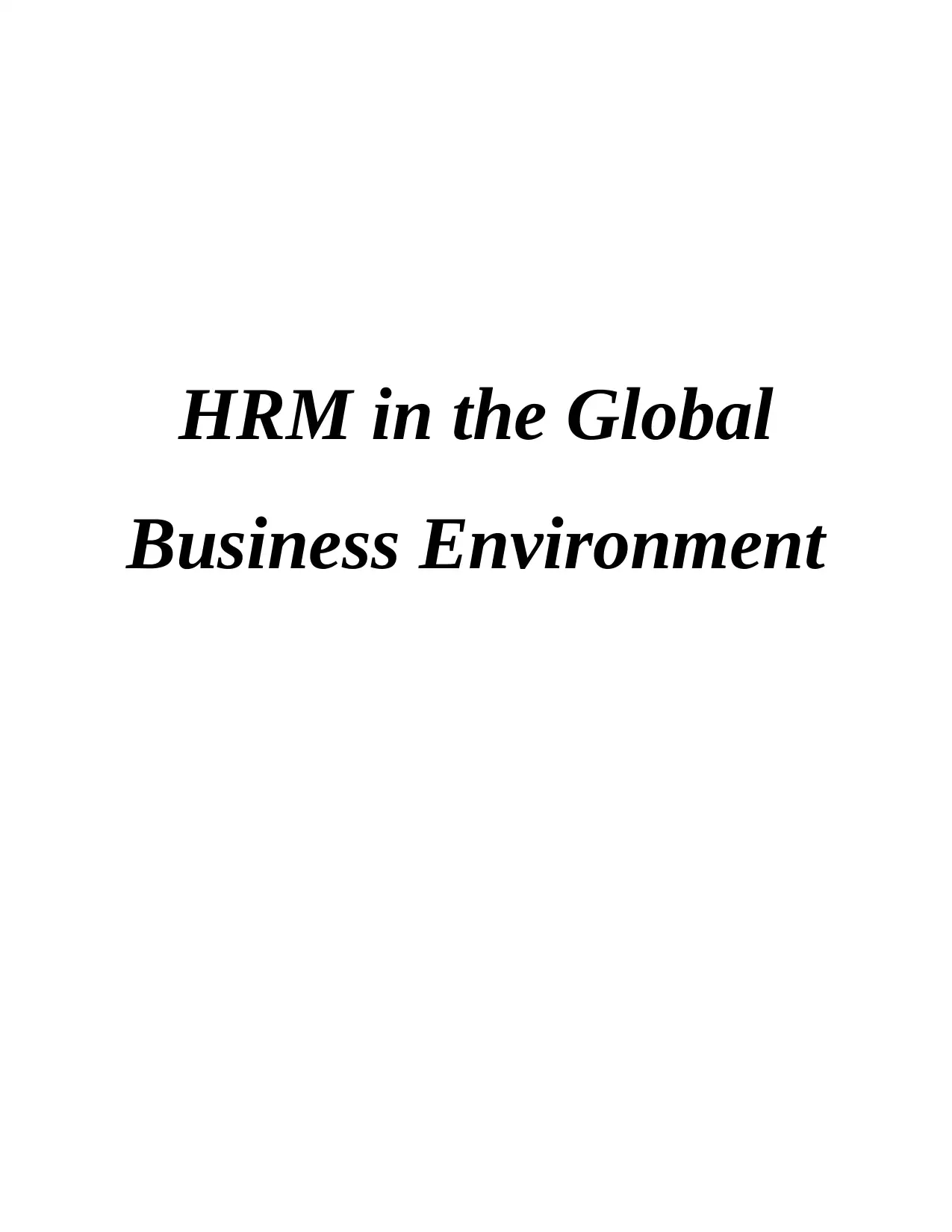
HRM in the Global
Business Environment
Business Environment
Paraphrase This Document
Need a fresh take? Get an instant paraphrase of this document with our AI Paraphraser
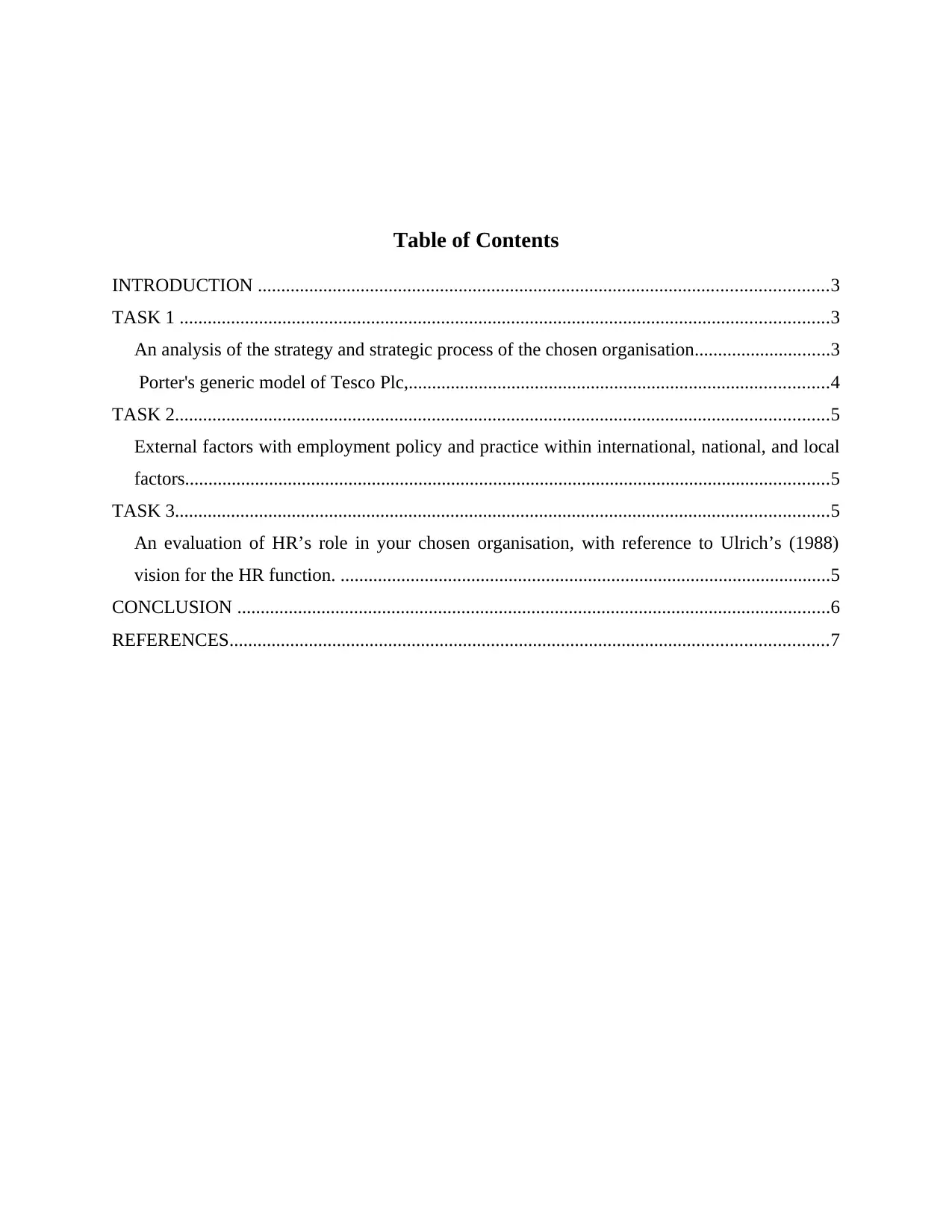
Table of Contents
INTRODUCTION ..........................................................................................................................3
TASK 1 ...........................................................................................................................................3
An analysis of the strategy and strategic process of the chosen organisation.............................3
Porter's generic model of Tesco Plc,..........................................................................................4
TASK 2............................................................................................................................................5
External factors with employment policy and practice within international, national, and local
factors..........................................................................................................................................5
TASK 3............................................................................................................................................5
An evaluation of HR’s role in your chosen organisation, with reference to Ulrich’s (1988)
vision for the HR function. .........................................................................................................5
CONCLUSION ...............................................................................................................................6
REFERENCES................................................................................................................................7
INTRODUCTION ..........................................................................................................................3
TASK 1 ...........................................................................................................................................3
An analysis of the strategy and strategic process of the chosen organisation.............................3
Porter's generic model of Tesco Plc,..........................................................................................4
TASK 2............................................................................................................................................5
External factors with employment policy and practice within international, national, and local
factors..........................................................................................................................................5
TASK 3............................................................................................................................................5
An evaluation of HR’s role in your chosen organisation, with reference to Ulrich’s (1988)
vision for the HR function. .........................................................................................................5
CONCLUSION ...............................................................................................................................6
REFERENCES................................................................................................................................7
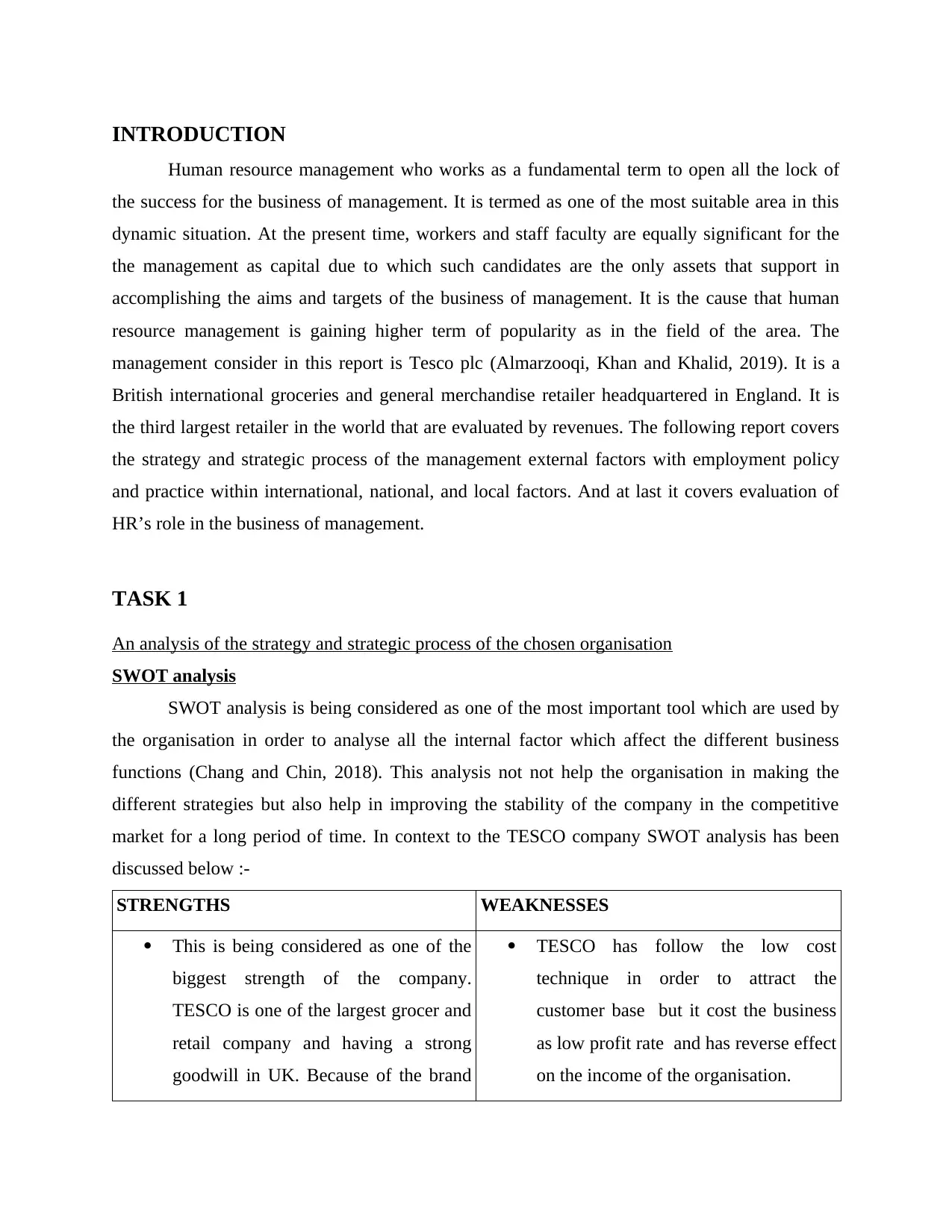
INTRODUCTION
Human resource management who works as a fundamental term to open all the lock of
the success for the business of management. It is termed as one of the most suitable area in this
dynamic situation. At the present time, workers and staff faculty are equally significant for the
the management as capital due to which such candidates are the only assets that support in
accomplishing the aims and targets of the business of management. It is the cause that human
resource management is gaining higher term of popularity as in the field of the area. The
management consider in this report is Tesco plc (Almarzooqi, Khan and Khalid, 2019). It is a
British international groceries and general merchandise retailer headquartered in England. It is
the third largest retailer in the world that are evaluated by revenues. The following report covers
the strategy and strategic process of the management external factors with employment policy
and practice within international, national, and local factors. And at last it covers evaluation of
HR’s role in the business of management.
TASK 1
An analysis of the strategy and strategic process of the chosen organisation
SWOT analysis
SWOT analysis is being considered as one of the most important tool which are used by
the organisation in order to analyse all the internal factor which affect the different business
functions (Chang and Chin, 2018). This analysis not not help the organisation in making the
different strategies but also help in improving the stability of the company in the competitive
market for a long period of time. In context to the TESCO company SWOT analysis has been
discussed below :-
STRENGTHS WEAKNESSES
This is being considered as one of the
biggest strength of the company.
TESCO is one of the largest grocer and
retail company and having a strong
goodwill in UK. Because of the brand
TESCO has follow the low cost
technique in order to attract the
customer base but it cost the business
as low profit rate and has reverse effect
on the income of the organisation.
Human resource management who works as a fundamental term to open all the lock of
the success for the business of management. It is termed as one of the most suitable area in this
dynamic situation. At the present time, workers and staff faculty are equally significant for the
the management as capital due to which such candidates are the only assets that support in
accomplishing the aims and targets of the business of management. It is the cause that human
resource management is gaining higher term of popularity as in the field of the area. The
management consider in this report is Tesco plc (Almarzooqi, Khan and Khalid, 2019). It is a
British international groceries and general merchandise retailer headquartered in England. It is
the third largest retailer in the world that are evaluated by revenues. The following report covers
the strategy and strategic process of the management external factors with employment policy
and practice within international, national, and local factors. And at last it covers evaluation of
HR’s role in the business of management.
TASK 1
An analysis of the strategy and strategic process of the chosen organisation
SWOT analysis
SWOT analysis is being considered as one of the most important tool which are used by
the organisation in order to analyse all the internal factor which affect the different business
functions (Chang and Chin, 2018). This analysis not not help the organisation in making the
different strategies but also help in improving the stability of the company in the competitive
market for a long period of time. In context to the TESCO company SWOT analysis has been
discussed below :-
STRENGTHS WEAKNESSES
This is being considered as one of the
biggest strength of the company.
TESCO is one of the largest grocer and
retail company and having a strong
goodwill in UK. Because of the brand
TESCO has follow the low cost
technique in order to attract the
customer base but it cost the business
as low profit rate and has reverse effect
on the income of the organisation.
⊘ This is a preview!⊘
Do you want full access?
Subscribe today to unlock all pages.

Trusted by 1+ million students worldwide
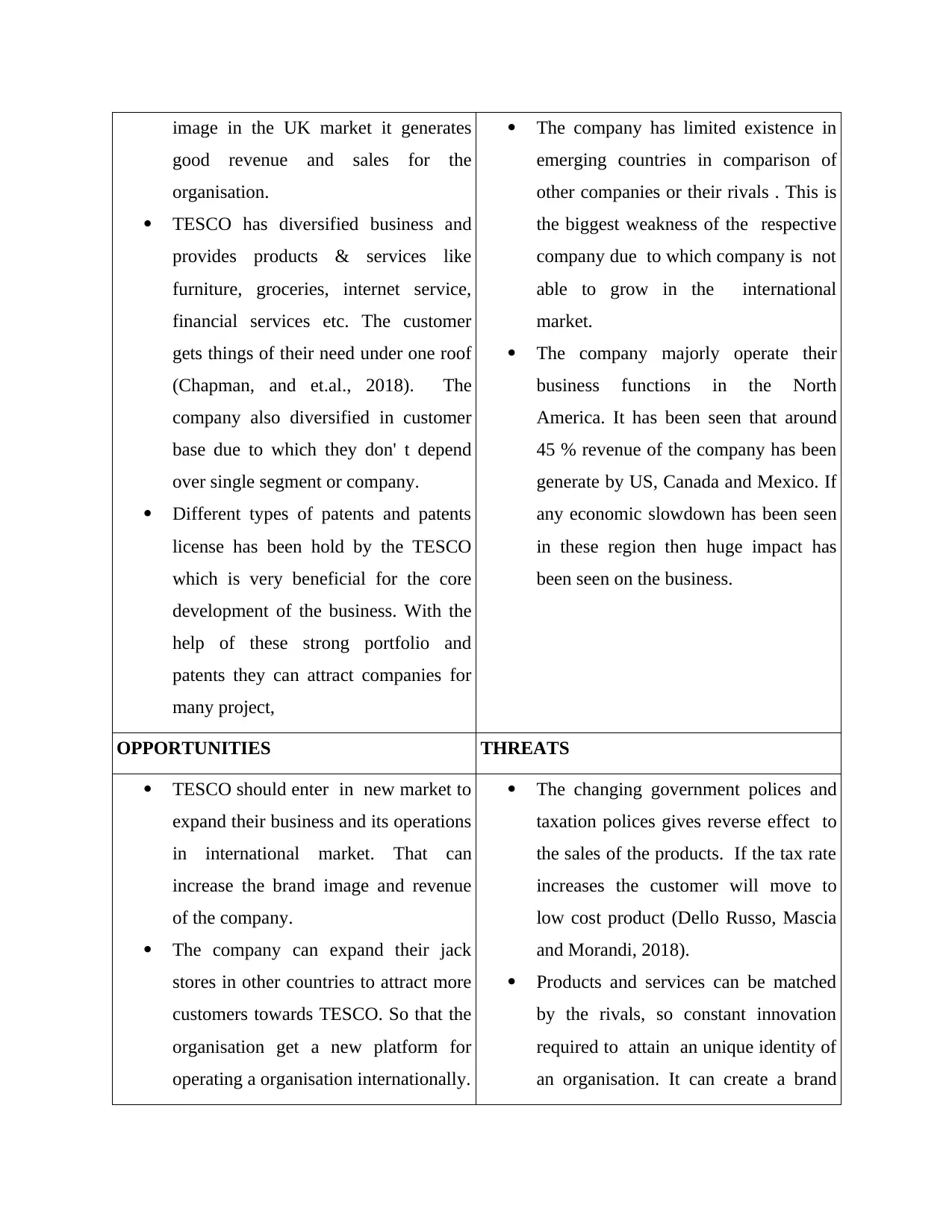
image in the UK market it generates
good revenue and sales for the
organisation.
TESCO has diversified business and
provides products & services like
furniture, groceries, internet service,
financial services etc. The customer
gets things of their need under one roof
(Chapman, and et.al., 2018). The
company also diversified in customer
base due to which they don' t depend
over single segment or company.
Different types of patents and patents
license has been hold by the TESCO
which is very beneficial for the core
development of the business. With the
help of these strong portfolio and
patents they can attract companies for
many project,
The company has limited existence in
emerging countries in comparison of
other companies or their rivals . This is
the biggest weakness of the respective
company due to which company is not
able to grow in the international
market.
The company majorly operate their
business functions in the North
America. It has been seen that around
45 % revenue of the company has been
generate by US, Canada and Mexico. If
any economic slowdown has been seen
in these region then huge impact has
been seen on the business.
OPPORTUNITIES THREATS
TESCO should enter in new market to
expand their business and its operations
in international market. That can
increase the brand image and revenue
of the company.
The company can expand their jack
stores in other countries to attract more
customers towards TESCO. So that the
organisation get a new platform for
operating a organisation internationally.
The changing government polices and
taxation polices gives reverse effect to
the sales of the products. If the tax rate
increases the customer will move to
low cost product (Dello Russo, Mascia
and Morandi, 2018).
Products and services can be matched
by the rivals, so constant innovation
required to attain an unique identity of
an organisation. It can create a brand
good revenue and sales for the
organisation.
TESCO has diversified business and
provides products & services like
furniture, groceries, internet service,
financial services etc. The customer
gets things of their need under one roof
(Chapman, and et.al., 2018). The
company also diversified in customer
base due to which they don' t depend
over single segment or company.
Different types of patents and patents
license has been hold by the TESCO
which is very beneficial for the core
development of the business. With the
help of these strong portfolio and
patents they can attract companies for
many project,
The company has limited existence in
emerging countries in comparison of
other companies or their rivals . This is
the biggest weakness of the respective
company due to which company is not
able to grow in the international
market.
The company majorly operate their
business functions in the North
America. It has been seen that around
45 % revenue of the company has been
generate by US, Canada and Mexico. If
any economic slowdown has been seen
in these region then huge impact has
been seen on the business.
OPPORTUNITIES THREATS
TESCO should enter in new market to
expand their business and its operations
in international market. That can
increase the brand image and revenue
of the company.
The company can expand their jack
stores in other countries to attract more
customers towards TESCO. So that the
organisation get a new platform for
operating a organisation internationally.
The changing government polices and
taxation polices gives reverse effect to
the sales of the products. If the tax rate
increases the customer will move to
low cost product (Dello Russo, Mascia
and Morandi, 2018).
Products and services can be matched
by the rivals, so constant innovation
required to attain an unique identity of
an organisation. It can create a brand
Paraphrase This Document
Need a fresh take? Get an instant paraphrase of this document with our AI Paraphraser
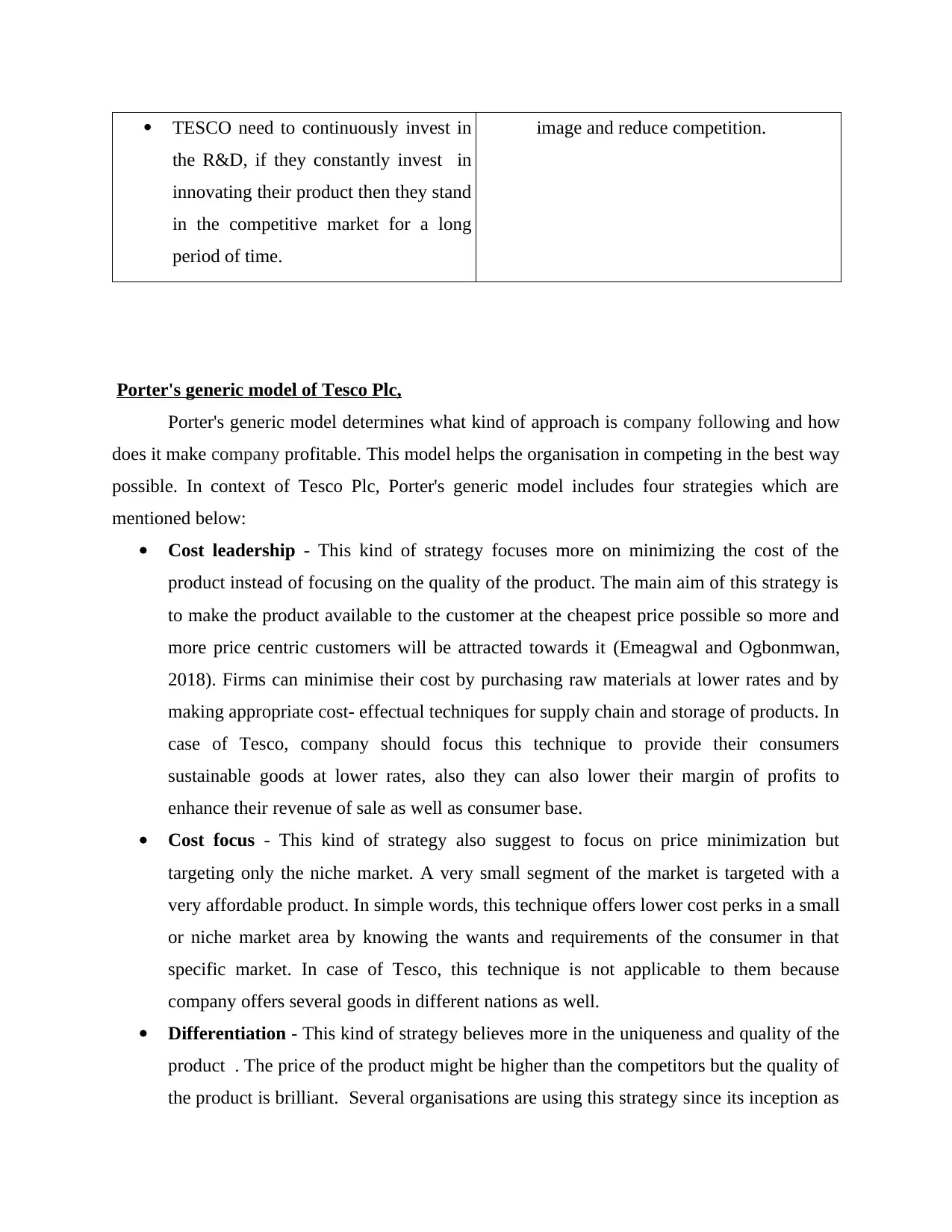
TESCO need to continuously invest in
the R&D, if they constantly invest in
innovating their product then they stand
in the competitive market for a long
period of time.
image and reduce competition.
Porter's generic model of Tesco Plc,
Porter's generic model determines what kind of approach is company following and how
does it make company profitable. This model helps the organisation in competing in the best way
possible. In context of Tesco Plc, Porter's generic model includes four strategies which are
mentioned below:
Cost leadership - This kind of strategy focuses more on minimizing the cost of the
product instead of focusing on the quality of the product. The main aim of this strategy is
to make the product available to the customer at the cheapest price possible so more and
more price centric customers will be attracted towards it (Emeagwal and Ogbonmwan,
2018). Firms can minimise their cost by purchasing raw materials at lower rates and by
making appropriate cost- effectual techniques for supply chain and storage of products. In
case of Tesco, company should focus this technique to provide their consumers
sustainable goods at lower rates, also they can also lower their margin of profits to
enhance their revenue of sale as well as consumer base.
Cost focus - This kind of strategy also suggest to focus on price minimization but
targeting only the niche market. A very small segment of the market is targeted with a
very affordable product. In simple words, this technique offers lower cost perks in a small
or niche market area by knowing the wants and requirements of the consumer in that
specific market. In case of Tesco, this technique is not applicable to them because
company offers several goods in different nations as well.
Differentiation - This kind of strategy believes more in the uniqueness and quality of the
product . The price of the product might be higher than the competitors but the quality of
the product is brilliant. Several organisations are using this strategy since its inception as
the R&D, if they constantly invest in
innovating their product then they stand
in the competitive market for a long
period of time.
image and reduce competition.
Porter's generic model of Tesco Plc,
Porter's generic model determines what kind of approach is company following and how
does it make company profitable. This model helps the organisation in competing in the best way
possible. In context of Tesco Plc, Porter's generic model includes four strategies which are
mentioned below:
Cost leadership - This kind of strategy focuses more on minimizing the cost of the
product instead of focusing on the quality of the product. The main aim of this strategy is
to make the product available to the customer at the cheapest price possible so more and
more price centric customers will be attracted towards it (Emeagwal and Ogbonmwan,
2018). Firms can minimise their cost by purchasing raw materials at lower rates and by
making appropriate cost- effectual techniques for supply chain and storage of products. In
case of Tesco, company should focus this technique to provide their consumers
sustainable goods at lower rates, also they can also lower their margin of profits to
enhance their revenue of sale as well as consumer base.
Cost focus - This kind of strategy also suggest to focus on price minimization but
targeting only the niche market. A very small segment of the market is targeted with a
very affordable product. In simple words, this technique offers lower cost perks in a small
or niche market area by knowing the wants and requirements of the consumer in that
specific market. In case of Tesco, this technique is not applicable to them because
company offers several goods in different nations as well.
Differentiation - This kind of strategy believes more in the uniqueness and quality of the
product . The price of the product might be higher than the competitors but the quality of
the product is brilliant. Several organisations are using this strategy since its inception as
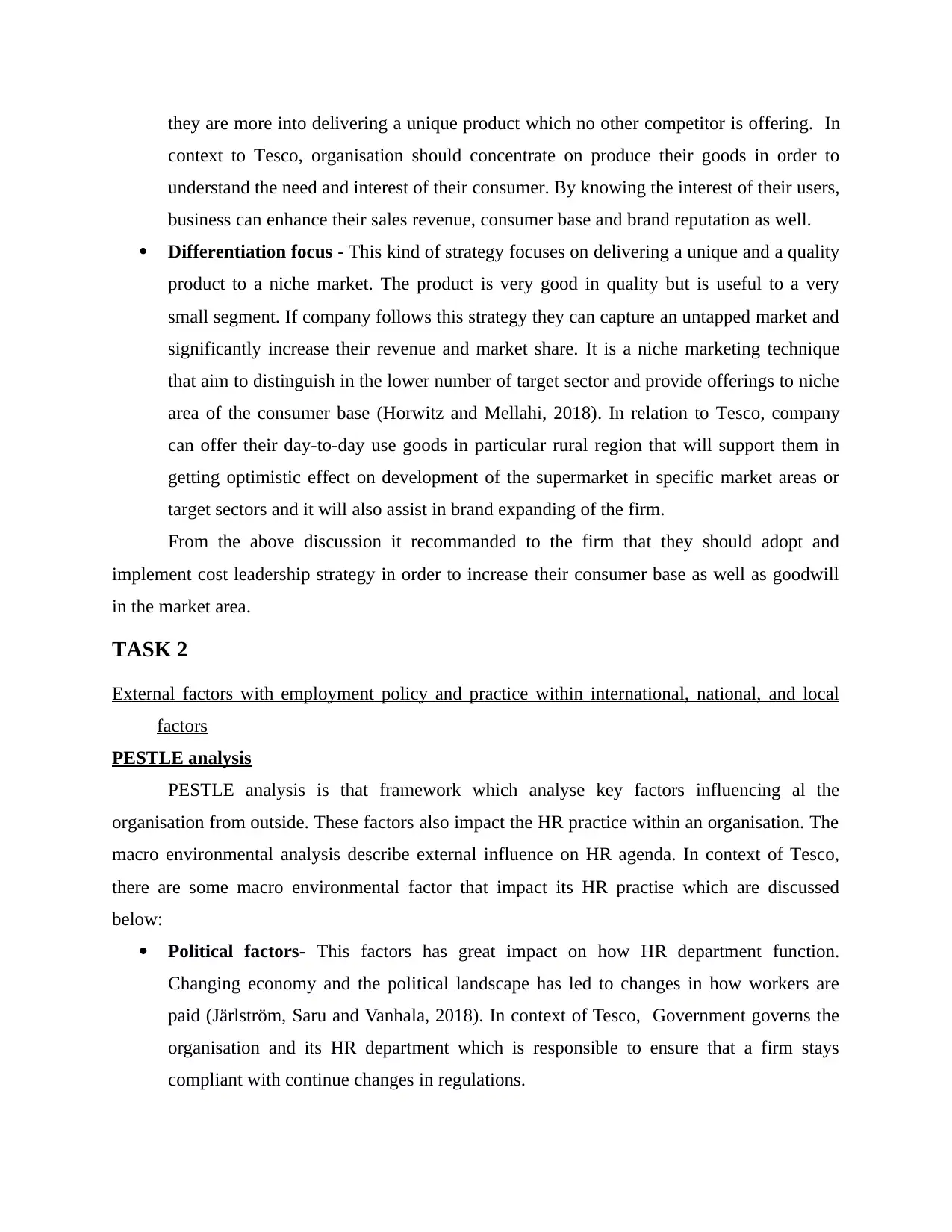
they are more into delivering a unique product which no other competitor is offering. In
context to Tesco, organisation should concentrate on produce their goods in order to
understand the need and interest of their consumer. By knowing the interest of their users,
business can enhance their sales revenue, consumer base and brand reputation as well.
Differentiation focus - This kind of strategy focuses on delivering a unique and a quality
product to a niche market. The product is very good in quality but is useful to a very
small segment. If company follows this strategy they can capture an untapped market and
significantly increase their revenue and market share. It is a niche marketing technique
that aim to distinguish in the lower number of target sector and provide offerings to niche
area of the consumer base (Horwitz and Mellahi, 2018). In relation to Tesco, company
can offer their day-to-day use goods in particular rural region that will support them in
getting optimistic effect on development of the supermarket in specific market areas or
target sectors and it will also assist in brand expanding of the firm.
From the above discussion it recommanded to the firm that they should adopt and
implement cost leadership strategy in order to increase their consumer base as well as goodwill
in the market area.
TASK 2
External factors with employment policy and practice within international, national, and local
factors
PESTLE analysis
PESTLE analysis is that framework which analyse key factors influencing al the
organisation from outside. These factors also impact the HR practice within an organisation. The
macro environmental analysis describe external influence on HR agenda. In context of Tesco,
there are some macro environmental factor that impact its HR practise which are discussed
below:
Political factors- This factors has great impact on how HR department function.
Changing economy and the political landscape has led to changes in how workers are
paid (Järlström, Saru and Vanhala, 2018). In context of Tesco, Government governs the
organisation and its HR department which is responsible to ensure that a firm stays
compliant with continue changes in regulations.
context to Tesco, organisation should concentrate on produce their goods in order to
understand the need and interest of their consumer. By knowing the interest of their users,
business can enhance their sales revenue, consumer base and brand reputation as well.
Differentiation focus - This kind of strategy focuses on delivering a unique and a quality
product to a niche market. The product is very good in quality but is useful to a very
small segment. If company follows this strategy they can capture an untapped market and
significantly increase their revenue and market share. It is a niche marketing technique
that aim to distinguish in the lower number of target sector and provide offerings to niche
area of the consumer base (Horwitz and Mellahi, 2018). In relation to Tesco, company
can offer their day-to-day use goods in particular rural region that will support them in
getting optimistic effect on development of the supermarket in specific market areas or
target sectors and it will also assist in brand expanding of the firm.
From the above discussion it recommanded to the firm that they should adopt and
implement cost leadership strategy in order to increase their consumer base as well as goodwill
in the market area.
TASK 2
External factors with employment policy and practice within international, national, and local
factors
PESTLE analysis
PESTLE analysis is that framework which analyse key factors influencing al the
organisation from outside. These factors also impact the HR practice within an organisation. The
macro environmental analysis describe external influence on HR agenda. In context of Tesco,
there are some macro environmental factor that impact its HR practise which are discussed
below:
Political factors- This factors has great impact on how HR department function.
Changing economy and the political landscape has led to changes in how workers are
paid (Järlström, Saru and Vanhala, 2018). In context of Tesco, Government governs the
organisation and its HR department which is responsible to ensure that a firm stays
compliant with continue changes in regulations.
⊘ This is a preview!⊘
Do you want full access?
Subscribe today to unlock all pages.

Trusted by 1+ million students worldwide
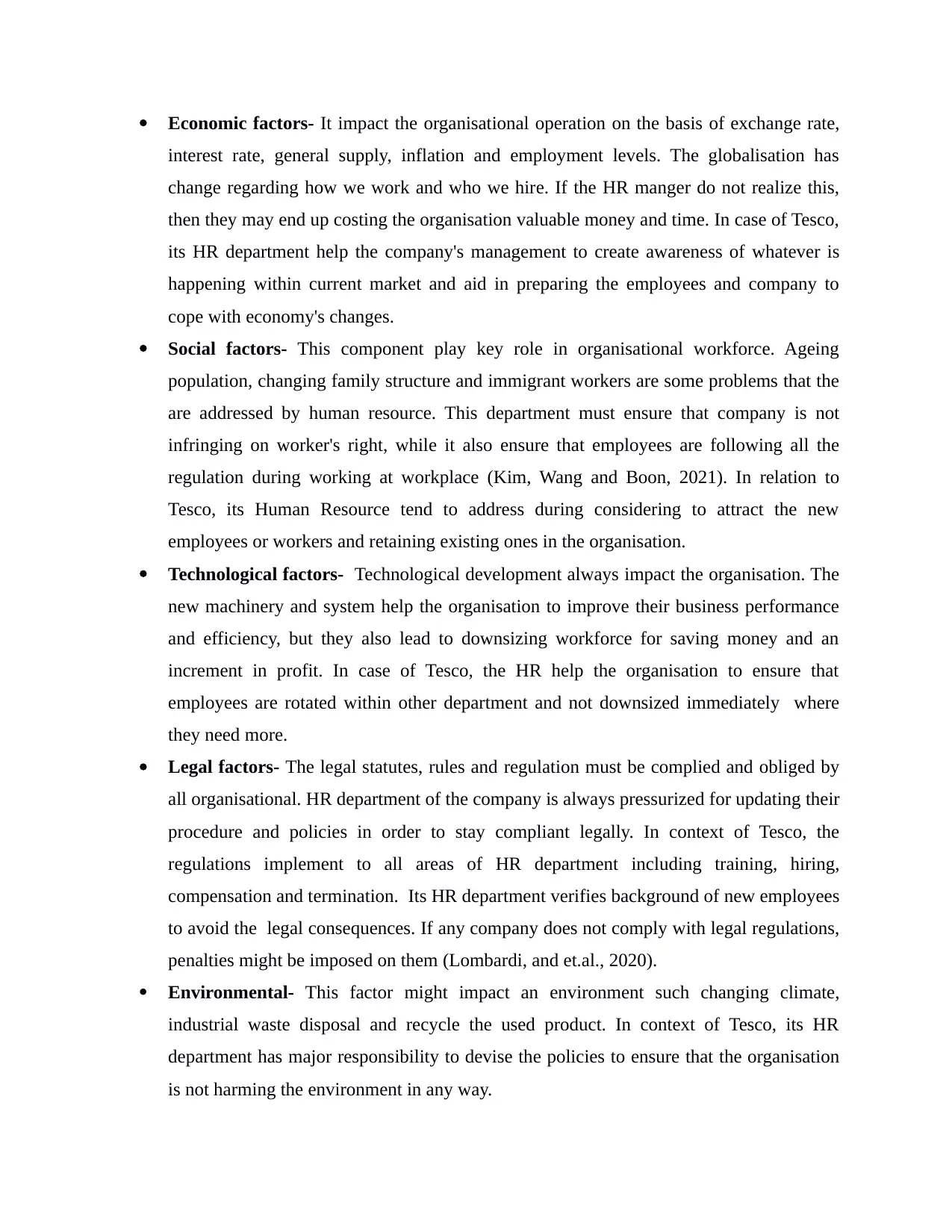
Economic factors- It impact the organisational operation on the basis of exchange rate,
interest rate, general supply, inflation and employment levels. The globalisation has
change regarding how we work and who we hire. If the HR manger do not realize this,
then they may end up costing the organisation valuable money and time. In case of Tesco,
its HR department help the company's management to create awareness of whatever is
happening within current market and aid in preparing the employees and company to
cope with economy's changes.
Social factors- This component play key role in organisational workforce. Ageing
population, changing family structure and immigrant workers are some problems that the
are addressed by human resource. This department must ensure that company is not
infringing on worker's right, while it also ensure that employees are following all the
regulation during working at workplace (Kim, Wang and Boon, 2021). In relation to
Tesco, its Human Resource tend to address during considering to attract the new
employees or workers and retaining existing ones in the organisation.
Technological factors- Technological development always impact the organisation. The
new machinery and system help the organisation to improve their business performance
and efficiency, but they also lead to downsizing workforce for saving money and an
increment in profit. In case of Tesco, the HR help the organisation to ensure that
employees are rotated within other department and not downsized immediately where
they need more.
Legal factors- The legal statutes, rules and regulation must be complied and obliged by
all organisational. HR department of the company is always pressurized for updating their
procedure and policies in order to stay compliant legally. In context of Tesco, the
regulations implement to all areas of HR department including training, hiring,
compensation and termination. Its HR department verifies background of new employees
to avoid the legal consequences. If any company does not comply with legal regulations,
penalties might be imposed on them (Lombardi, and et.al., 2020).
Environmental- This factor might impact an environment such changing climate,
industrial waste disposal and recycle the used product. In context of Tesco, its HR
department has major responsibility to devise the policies to ensure that the organisation
is not harming the environment in any way.
interest rate, general supply, inflation and employment levels. The globalisation has
change regarding how we work and who we hire. If the HR manger do not realize this,
then they may end up costing the organisation valuable money and time. In case of Tesco,
its HR department help the company's management to create awareness of whatever is
happening within current market and aid in preparing the employees and company to
cope with economy's changes.
Social factors- This component play key role in organisational workforce. Ageing
population, changing family structure and immigrant workers are some problems that the
are addressed by human resource. This department must ensure that company is not
infringing on worker's right, while it also ensure that employees are following all the
regulation during working at workplace (Kim, Wang and Boon, 2021). In relation to
Tesco, its Human Resource tend to address during considering to attract the new
employees or workers and retaining existing ones in the organisation.
Technological factors- Technological development always impact the organisation. The
new machinery and system help the organisation to improve their business performance
and efficiency, but they also lead to downsizing workforce for saving money and an
increment in profit. In case of Tesco, the HR help the organisation to ensure that
employees are rotated within other department and not downsized immediately where
they need more.
Legal factors- The legal statutes, rules and regulation must be complied and obliged by
all organisational. HR department of the company is always pressurized for updating their
procedure and policies in order to stay compliant legally. In context of Tesco, the
regulations implement to all areas of HR department including training, hiring,
compensation and termination. Its HR department verifies background of new employees
to avoid the legal consequences. If any company does not comply with legal regulations,
penalties might be imposed on them (Lombardi, and et.al., 2020).
Environmental- This factor might impact an environment such changing climate,
industrial waste disposal and recycle the used product. In context of Tesco, its HR
department has major responsibility to devise the policies to ensure that the organisation
is not harming the environment in any way.
Paraphrase This Document
Need a fresh take? Get an instant paraphrase of this document with our AI Paraphraser
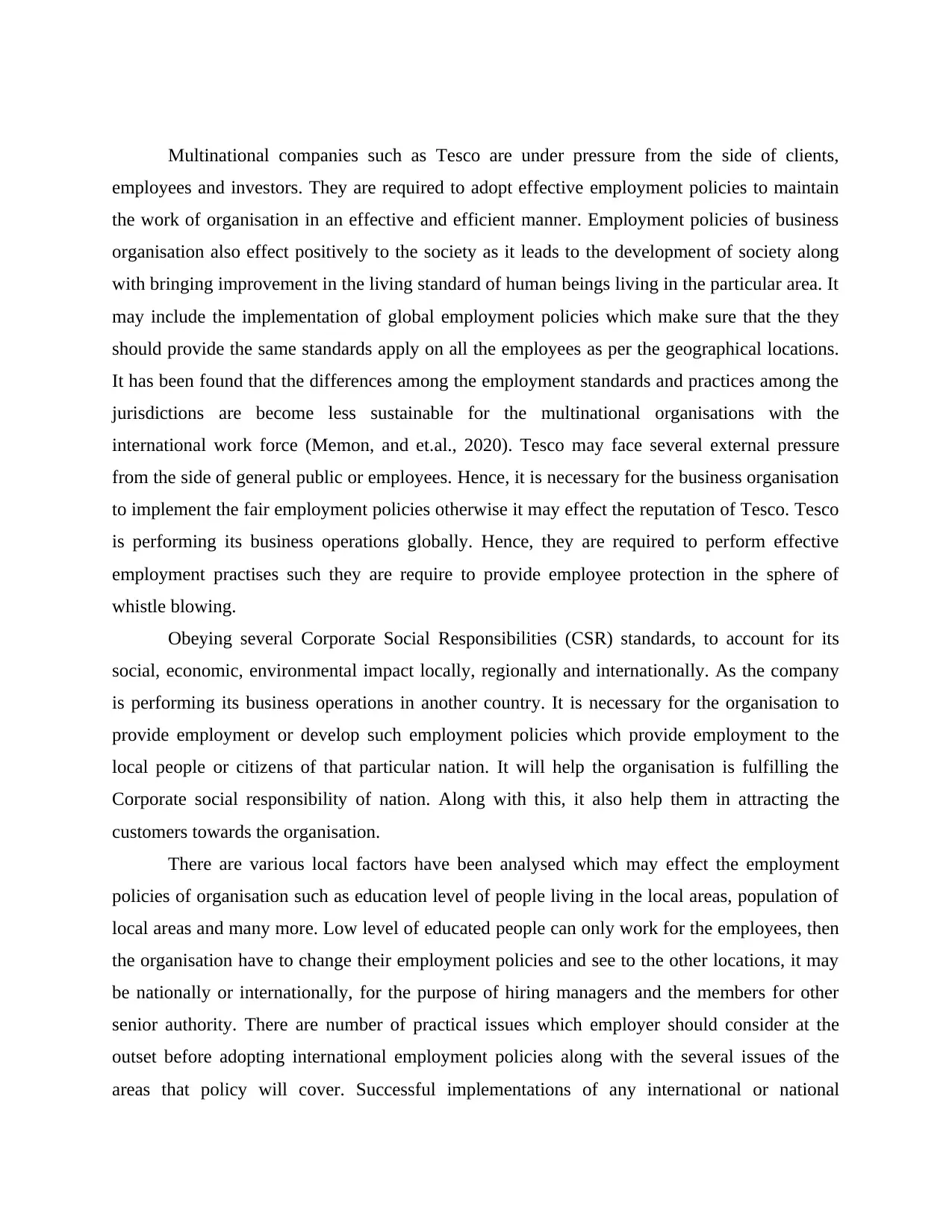
Multinational companies such as Tesco are under pressure from the side of clients,
employees and investors. They are required to adopt effective employment policies to maintain
the work of organisation in an effective and efficient manner. Employment policies of business
organisation also effect positively to the society as it leads to the development of society along
with bringing improvement in the living standard of human beings living in the particular area. It
may include the implementation of global employment policies which make sure that the they
should provide the same standards apply on all the employees as per the geographical locations.
It has been found that the differences among the employment standards and practices among the
jurisdictions are become less sustainable for the multinational organisations with the
international work force (Memon, and et.al., 2020). Tesco may face several external pressure
from the side of general public or employees. Hence, it is necessary for the business organisation
to implement the fair employment policies otherwise it may effect the reputation of Tesco. Tesco
is performing its business operations globally. Hence, they are required to perform effective
employment practises such they are require to provide employee protection in the sphere of
whistle blowing.
Obeying several Corporate Social Responsibilities (CSR) standards, to account for its
social, economic, environmental impact locally, regionally and internationally. As the company
is performing its business operations in another country. It is necessary for the organisation to
provide employment or develop such employment policies which provide employment to the
local people or citizens of that particular nation. It will help the organisation is fulfilling the
Corporate social responsibility of nation. Along with this, it also help them in attracting the
customers towards the organisation.
There are various local factors have been analysed which may effect the employment
policies of organisation such as education level of people living in the local areas, population of
local areas and many more. Low level of educated people can only work for the employees, then
the organisation have to change their employment policies and see to the other locations, it may
be nationally or internationally, for the purpose of hiring managers and the members for other
senior authority. There are number of practical issues which employer should consider at the
outset before adopting international employment policies along with the several issues of the
areas that policy will cover. Successful implementations of any international or national
employees and investors. They are required to adopt effective employment policies to maintain
the work of organisation in an effective and efficient manner. Employment policies of business
organisation also effect positively to the society as it leads to the development of society along
with bringing improvement in the living standard of human beings living in the particular area. It
may include the implementation of global employment policies which make sure that the they
should provide the same standards apply on all the employees as per the geographical locations.
It has been found that the differences among the employment standards and practices among the
jurisdictions are become less sustainable for the multinational organisations with the
international work force (Memon, and et.al., 2020). Tesco may face several external pressure
from the side of general public or employees. Hence, it is necessary for the business organisation
to implement the fair employment policies otherwise it may effect the reputation of Tesco. Tesco
is performing its business operations globally. Hence, they are required to perform effective
employment practises such they are require to provide employee protection in the sphere of
whistle blowing.
Obeying several Corporate Social Responsibilities (CSR) standards, to account for its
social, economic, environmental impact locally, regionally and internationally. As the company
is performing its business operations in another country. It is necessary for the organisation to
provide employment or develop such employment policies which provide employment to the
local people or citizens of that particular nation. It will help the organisation is fulfilling the
Corporate social responsibility of nation. Along with this, it also help them in attracting the
customers towards the organisation.
There are various local factors have been analysed which may effect the employment
policies of organisation such as education level of people living in the local areas, population of
local areas and many more. Low level of educated people can only work for the employees, then
the organisation have to change their employment policies and see to the other locations, it may
be nationally or internationally, for the purpose of hiring managers and the members for other
senior authority. There are number of practical issues which employer should consider at the
outset before adopting international employment policies along with the several issues of the
areas that policy will cover. Successful implementations of any international or national
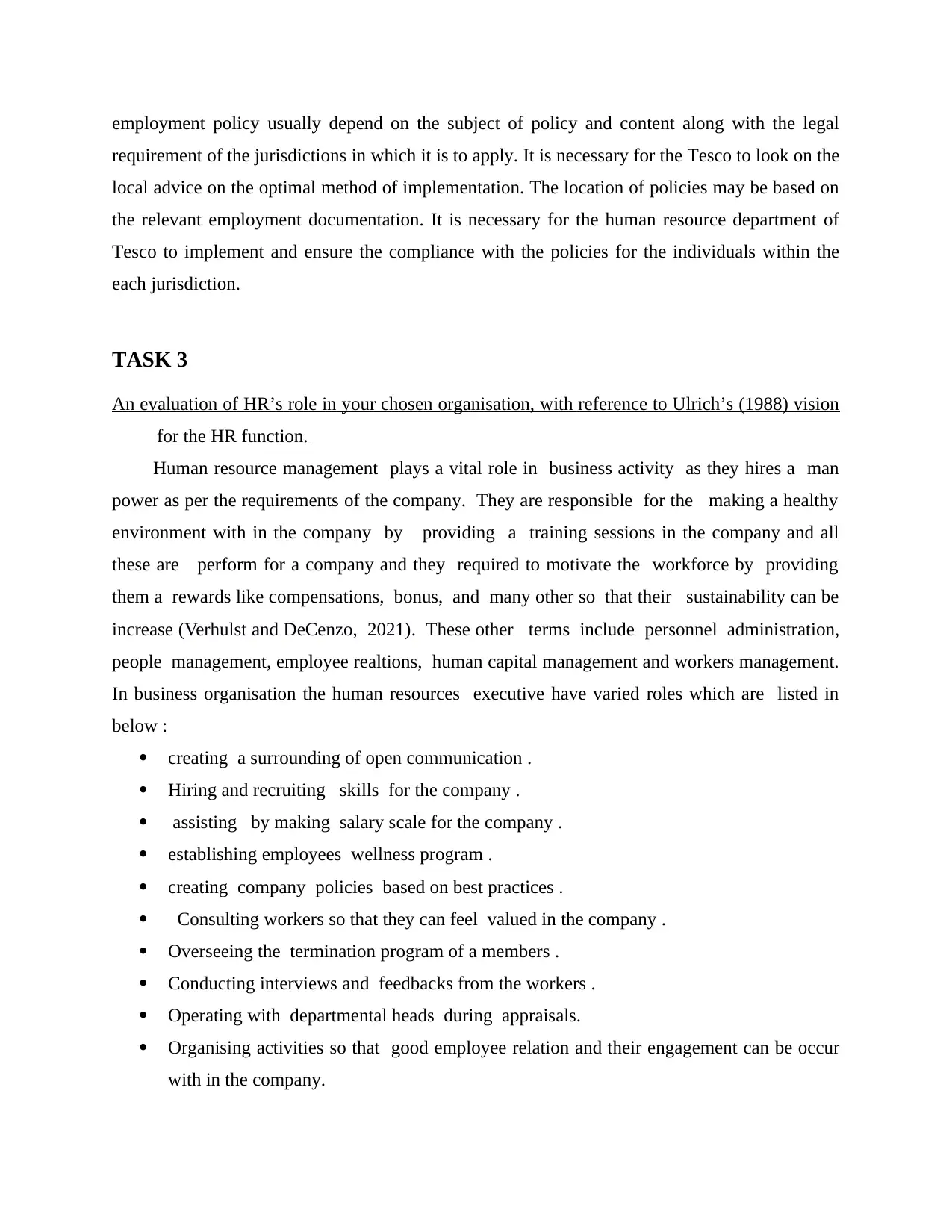
employment policy usually depend on the subject of policy and content along with the legal
requirement of the jurisdictions in which it is to apply. It is necessary for the Tesco to look on the
local advice on the optimal method of implementation. The location of policies may be based on
the relevant employment documentation. It is necessary for the human resource department of
Tesco to implement and ensure the compliance with the policies for the individuals within the
each jurisdiction.
TASK 3
An evaluation of HR’s role in your chosen organisation, with reference to Ulrich’s (1988) vision
for the HR function.
Human resource management plays a vital role in business activity as they hires a man
power as per the requirements of the company. They are responsible for the making a healthy
environment with in the company by providing a training sessions in the company and all
these are perform for a company and they required to motivate the workforce by providing
them a rewards like compensations, bonus, and many other so that their sustainability can be
increase (Verhulst and DeCenzo, 2021). These other terms include personnel administration,
people management, employee realtions, human capital management and workers management.
In business organisation the human resources executive have varied roles which are listed in
below :
creating a surrounding of open communication .
Hiring and recruiting skills for the company .
assisting by making salary scale for the company .
establishing employees wellness program .
creating company policies based on best practices .
Consulting workers so that they can feel valued in the company .
Overseeing the termination program of a members .
Conducting interviews and feedbacks from the workers .
Operating with departmental heads during appraisals.
Organising activities so that good employee relation and their engagement can be occur
with in the company.
requirement of the jurisdictions in which it is to apply. It is necessary for the Tesco to look on the
local advice on the optimal method of implementation. The location of policies may be based on
the relevant employment documentation. It is necessary for the human resource department of
Tesco to implement and ensure the compliance with the policies for the individuals within the
each jurisdiction.
TASK 3
An evaluation of HR’s role in your chosen organisation, with reference to Ulrich’s (1988) vision
for the HR function.
Human resource management plays a vital role in business activity as they hires a man
power as per the requirements of the company. They are responsible for the making a healthy
environment with in the company by providing a training sessions in the company and all
these are perform for a company and they required to motivate the workforce by providing
them a rewards like compensations, bonus, and many other so that their sustainability can be
increase (Verhulst and DeCenzo, 2021). These other terms include personnel administration,
people management, employee realtions, human capital management and workers management.
In business organisation the human resources executive have varied roles which are listed in
below :
creating a surrounding of open communication .
Hiring and recruiting skills for the company .
assisting by making salary scale for the company .
establishing employees wellness program .
creating company policies based on best practices .
Consulting workers so that they can feel valued in the company .
Overseeing the termination program of a members .
Conducting interviews and feedbacks from the workers .
Operating with departmental heads during appraisals.
Organising activities so that good employee relation and their engagement can be occur
with in the company.
⊘ This is a preview!⊘
Do you want full access?
Subscribe today to unlock all pages.

Trusted by 1+ million students worldwide
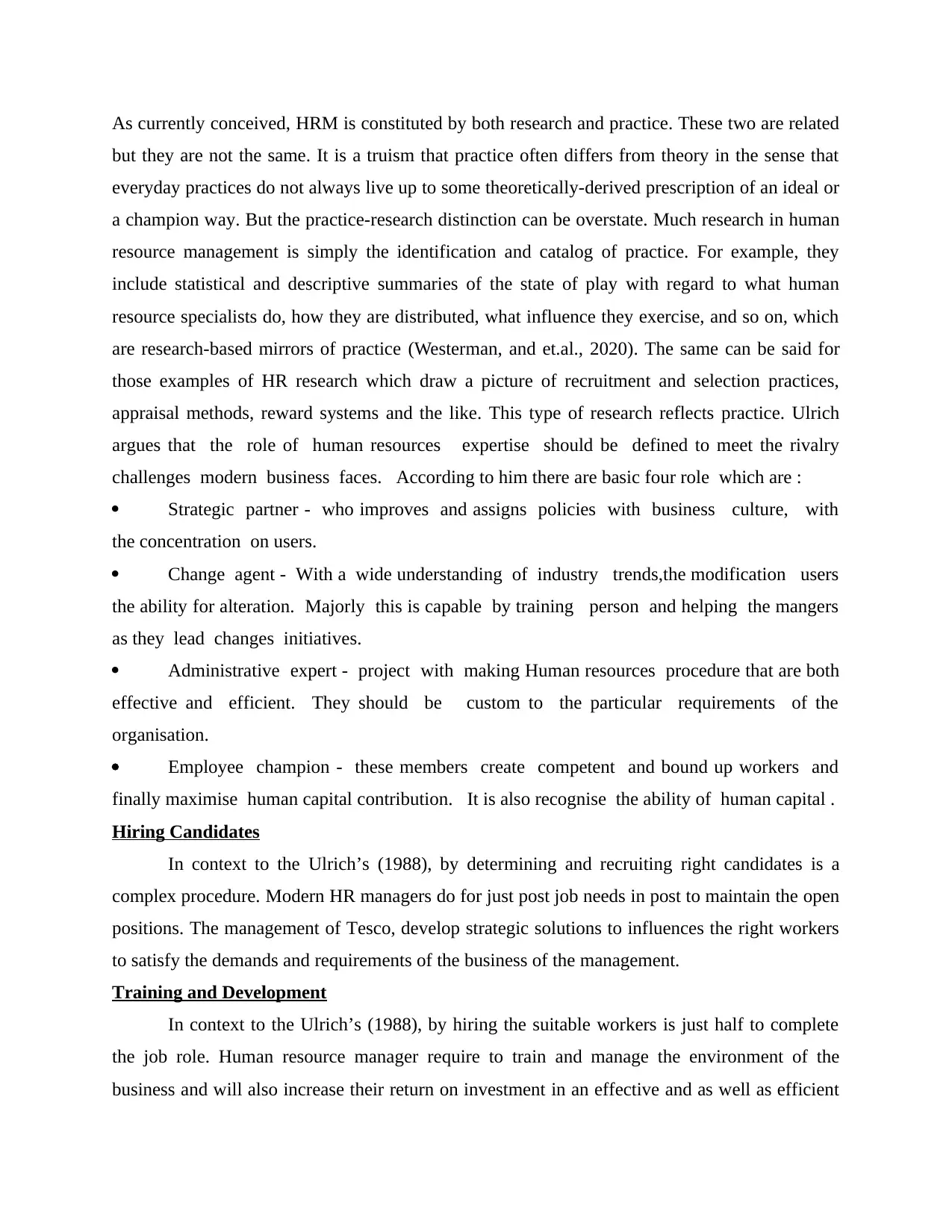
As currently conceived, HRM is constituted by both research and practice. These two are related
but they are not the same. It is a truism that practice often differs from theory in the sense that
everyday practices do not always live up to some theoretically-derived prescription of an ideal or
a champion way. But the practice-research distinction can be overstate. Much research in human
resource management is simply the identification and catalog of practice. For example, they
include statistical and descriptive summaries of the state of play with regard to what human
resource specialists do, how they are distributed, what influence they exercise, and so on, which
are research-based mirrors of practice (Westerman, and et.al., 2020). The same can be said for
those examples of HR research which draw a picture of recruitment and selection practices,
appraisal methods, reward systems and the like. This type of research reflects practice. Ulrich
argues that the role of human resources expertise should be defined to meet the rivalry
challenges modern business faces. According to him there are basic four role which are :
Strategic partner - who improves and assigns policies with business culture, with
the concentration on users.
Change agent - With a wide understanding of industry trends,the modification users
the ability for alteration. Majorly this is capable by training person and helping the mangers
as they lead changes initiatives.
Administrative expert - project with making Human resources procedure that are both
effective and efficient. They should be custom to the particular requirements of the
organisation.
Employee champion - these members create competent and bound up workers and
finally maximise human capital contribution. It is also recognise the ability of human capital .
Hiring Candidates
In context to the Ulrich’s (1988), by determining and recruiting right candidates is a
complex procedure. Modern HR managers do for just post job needs in post to maintain the open
positions. The management of Tesco, develop strategic solutions to influences the right workers
to satisfy the demands and requirements of the business of the management.
Training and Development
In context to the Ulrich’s (1988), by hiring the suitable workers is just half to complete
the job role. Human resource manager require to train and manage the environment of the
business and will also increase their return on investment in an effective and as well as efficient
but they are not the same. It is a truism that practice often differs from theory in the sense that
everyday practices do not always live up to some theoretically-derived prescription of an ideal or
a champion way. But the practice-research distinction can be overstate. Much research in human
resource management is simply the identification and catalog of practice. For example, they
include statistical and descriptive summaries of the state of play with regard to what human
resource specialists do, how they are distributed, what influence they exercise, and so on, which
are research-based mirrors of practice (Westerman, and et.al., 2020). The same can be said for
those examples of HR research which draw a picture of recruitment and selection practices,
appraisal methods, reward systems and the like. This type of research reflects practice. Ulrich
argues that the role of human resources expertise should be defined to meet the rivalry
challenges modern business faces. According to him there are basic four role which are :
Strategic partner - who improves and assigns policies with business culture, with
the concentration on users.
Change agent - With a wide understanding of industry trends,the modification users
the ability for alteration. Majorly this is capable by training person and helping the mangers
as they lead changes initiatives.
Administrative expert - project with making Human resources procedure that are both
effective and efficient. They should be custom to the particular requirements of the
organisation.
Employee champion - these members create competent and bound up workers and
finally maximise human capital contribution. It is also recognise the ability of human capital .
Hiring Candidates
In context to the Ulrich’s (1988), by determining and recruiting right candidates is a
complex procedure. Modern HR managers do for just post job needs in post to maintain the open
positions. The management of Tesco, develop strategic solutions to influences the right workers
to satisfy the demands and requirements of the business of the management.
Training and Development
In context to the Ulrich’s (1988), by hiring the suitable workers is just half to complete
the job role. Human resource manager require to train and manage the environment of the
business and will also increase their return on investment in an effective and as well as efficient
Paraphrase This Document
Need a fresh take? Get an instant paraphrase of this document with our AI Paraphraser
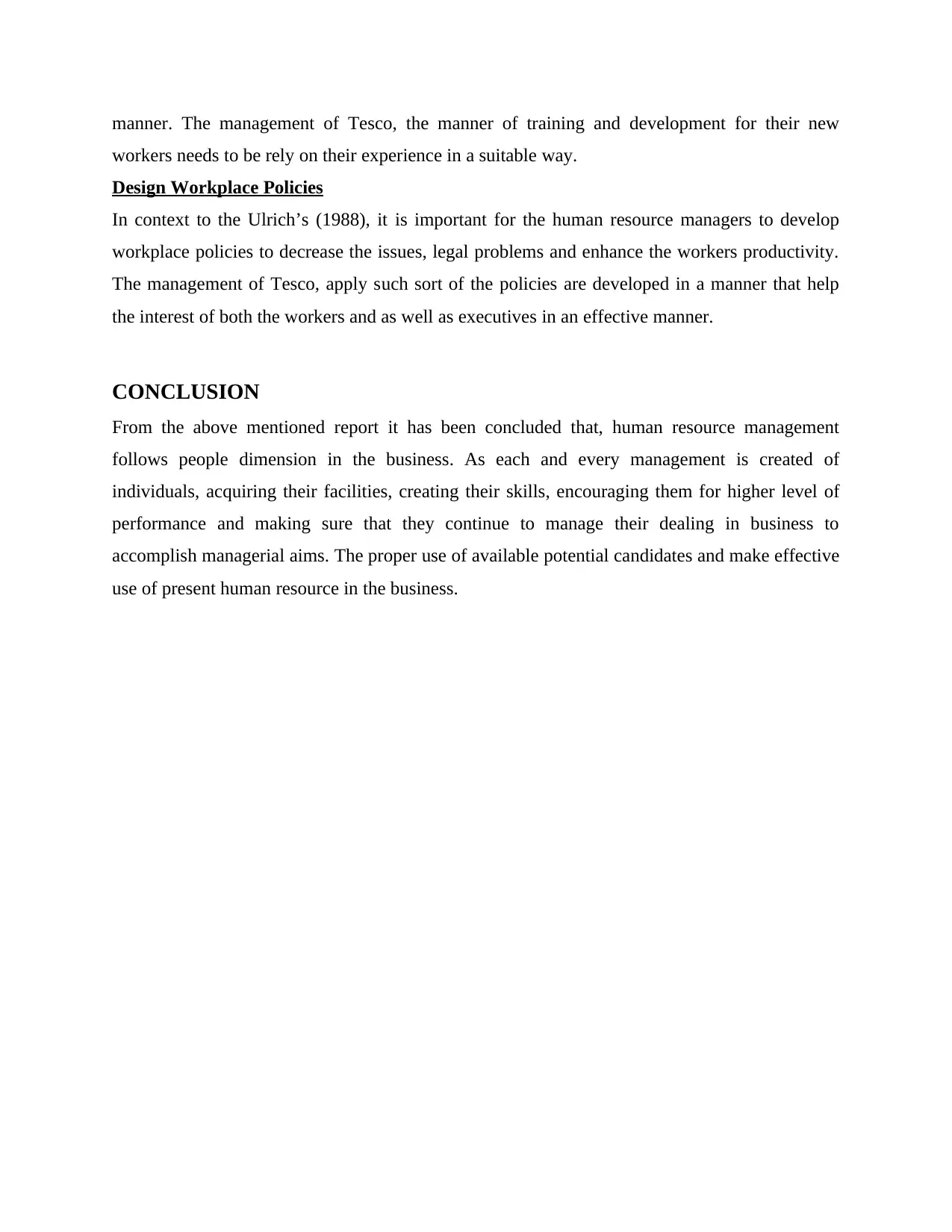
manner. The management of Tesco, the manner of training and development for their new
workers needs to be rely on their experience in a suitable way.
Design Workplace Policies
In context to the Ulrich’s (1988), it is important for the human resource managers to develop
workplace policies to decrease the issues, legal problems and enhance the workers productivity.
The management of Tesco, apply such sort of the policies are developed in a manner that help
the interest of both the workers and as well as executives in an effective manner.
CONCLUSION
From the above mentioned report it has been concluded that, human resource management
follows people dimension in the business. As each and every management is created of
individuals, acquiring their facilities, creating their skills, encouraging them for higher level of
performance and making sure that they continue to manage their dealing in business to
accomplish managerial aims. The proper use of available potential candidates and make effective
use of present human resource in the business.
workers needs to be rely on their experience in a suitable way.
Design Workplace Policies
In context to the Ulrich’s (1988), it is important for the human resource managers to develop
workplace policies to decrease the issues, legal problems and enhance the workers productivity.
The management of Tesco, apply such sort of the policies are developed in a manner that help
the interest of both the workers and as well as executives in an effective manner.
CONCLUSION
From the above mentioned report it has been concluded that, human resource management
follows people dimension in the business. As each and every management is created of
individuals, acquiring their facilities, creating their skills, encouraging them for higher level of
performance and making sure that they continue to manage their dealing in business to
accomplish managerial aims. The proper use of available potential candidates and make effective
use of present human resource in the business.
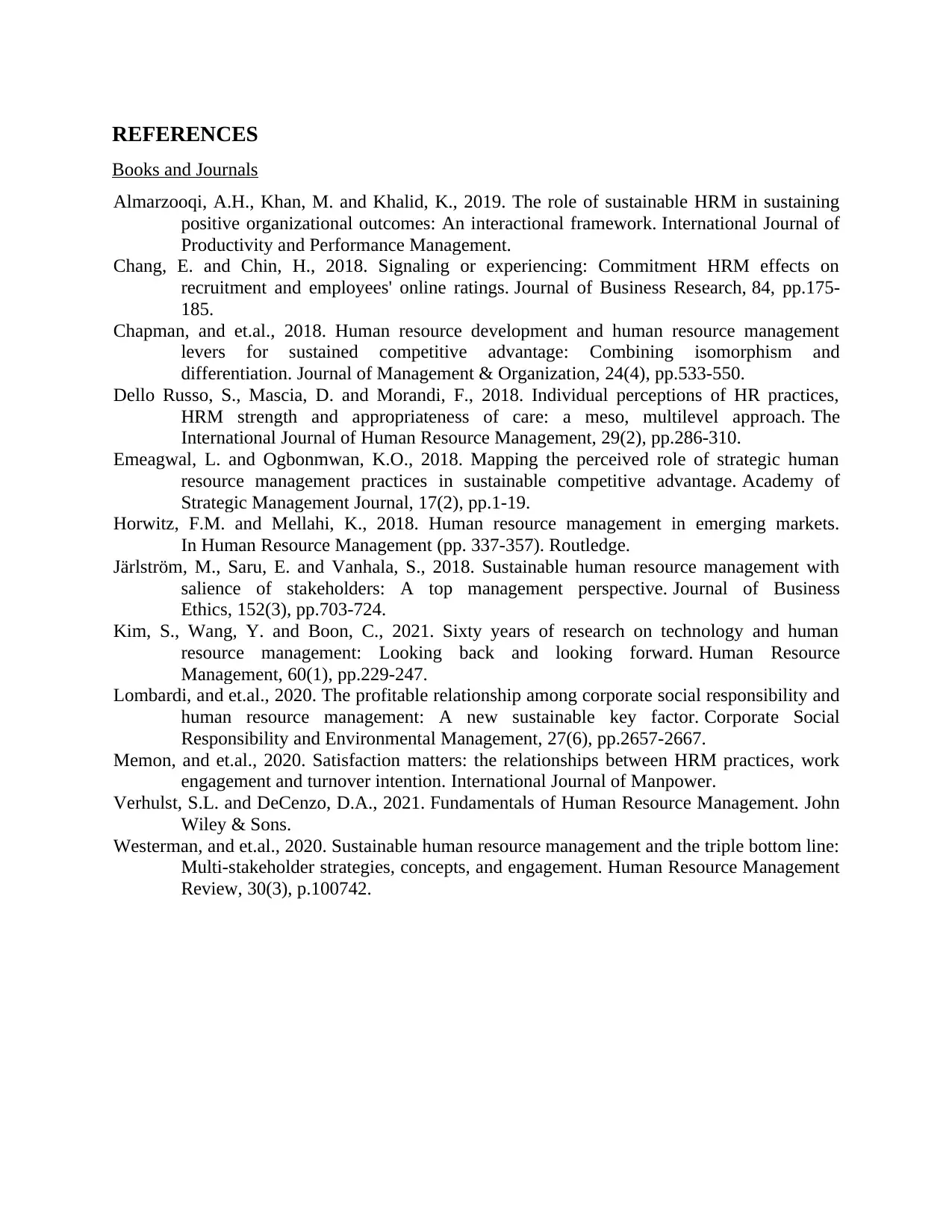
REFERENCES
Books and Journals
Almarzooqi, A.H., Khan, M. and Khalid, K., 2019. The role of sustainable HRM in sustaining
positive organizational outcomes: An interactional framework. International Journal of
Productivity and Performance Management.
Chang, E. and Chin, H., 2018. Signaling or experiencing: Commitment HRM effects on
recruitment and employees' online ratings. Journal of Business Research, 84, pp.175-
185.
Chapman, and et.al., 2018. Human resource development and human resource management
levers for sustained competitive advantage: Combining isomorphism and
differentiation. Journal of Management & Organization, 24(4), pp.533-550.
Dello Russo, S., Mascia, D. and Morandi, F., 2018. Individual perceptions of HR practices,
HRM strength and appropriateness of care: a meso, multilevel approach. The
International Journal of Human Resource Management, 29(2), pp.286-310.
Emeagwal, L. and Ogbonmwan, K.O., 2018. Mapping the perceived role of strategic human
resource management practices in sustainable competitive advantage. Academy of
Strategic Management Journal, 17(2), pp.1-19.
Horwitz, F.M. and Mellahi, K., 2018. Human resource management in emerging markets.
In Human Resource Management (pp. 337-357). Routledge.
Järlström, M., Saru, E. and Vanhala, S., 2018. Sustainable human resource management with
salience of stakeholders: A top management perspective. Journal of Business
Ethics, 152(3), pp.703-724.
Kim, S., Wang, Y. and Boon, C., 2021. Sixty years of research on technology and human
resource management: Looking back and looking forward. Human Resource
Management, 60(1), pp.229-247.
Lombardi, and et.al., 2020. The profitable relationship among corporate social responsibility and
human resource management: A new sustainable key factor. Corporate Social
Responsibility and Environmental Management, 27(6), pp.2657-2667.
Memon, and et.al., 2020. Satisfaction matters: the relationships between HRM practices, work
engagement and turnover intention. International Journal of Manpower.
Verhulst, S.L. and DeCenzo, D.A., 2021. Fundamentals of Human Resource Management. John
Wiley & Sons.
Westerman, and et.al., 2020. Sustainable human resource management and the triple bottom line:
Multi-stakeholder strategies, concepts, and engagement. Human Resource Management
Review, 30(3), p.100742.
Books and Journals
Almarzooqi, A.H., Khan, M. and Khalid, K., 2019. The role of sustainable HRM in sustaining
positive organizational outcomes: An interactional framework. International Journal of
Productivity and Performance Management.
Chang, E. and Chin, H., 2018. Signaling or experiencing: Commitment HRM effects on
recruitment and employees' online ratings. Journal of Business Research, 84, pp.175-
185.
Chapman, and et.al., 2018. Human resource development and human resource management
levers for sustained competitive advantage: Combining isomorphism and
differentiation. Journal of Management & Organization, 24(4), pp.533-550.
Dello Russo, S., Mascia, D. and Morandi, F., 2018. Individual perceptions of HR practices,
HRM strength and appropriateness of care: a meso, multilevel approach. The
International Journal of Human Resource Management, 29(2), pp.286-310.
Emeagwal, L. and Ogbonmwan, K.O., 2018. Mapping the perceived role of strategic human
resource management practices in sustainable competitive advantage. Academy of
Strategic Management Journal, 17(2), pp.1-19.
Horwitz, F.M. and Mellahi, K., 2018. Human resource management in emerging markets.
In Human Resource Management (pp. 337-357). Routledge.
Järlström, M., Saru, E. and Vanhala, S., 2018. Sustainable human resource management with
salience of stakeholders: A top management perspective. Journal of Business
Ethics, 152(3), pp.703-724.
Kim, S., Wang, Y. and Boon, C., 2021. Sixty years of research on technology and human
resource management: Looking back and looking forward. Human Resource
Management, 60(1), pp.229-247.
Lombardi, and et.al., 2020. The profitable relationship among corporate social responsibility and
human resource management: A new sustainable key factor. Corporate Social
Responsibility and Environmental Management, 27(6), pp.2657-2667.
Memon, and et.al., 2020. Satisfaction matters: the relationships between HRM practices, work
engagement and turnover intention. International Journal of Manpower.
Verhulst, S.L. and DeCenzo, D.A., 2021. Fundamentals of Human Resource Management. John
Wiley & Sons.
Westerman, and et.al., 2020. Sustainable human resource management and the triple bottom line:
Multi-stakeholder strategies, concepts, and engagement. Human Resource Management
Review, 30(3), p.100742.
⊘ This is a preview!⊘
Do you want full access?
Subscribe today to unlock all pages.

Trusted by 1+ million students worldwide
1 out of 12
Related Documents
Your All-in-One AI-Powered Toolkit for Academic Success.
+13062052269
info@desklib.com
Available 24*7 on WhatsApp / Email
![[object Object]](/_next/static/media/star-bottom.7253800d.svg)
Unlock your academic potential
Copyright © 2020–2025 A2Z Services. All Rights Reserved. Developed and managed by ZUCOL.





